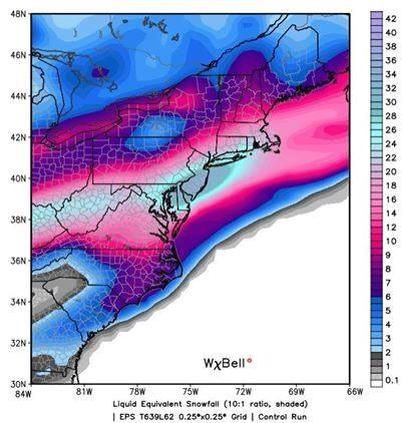Beware Social Media Weather Hype: Dire Snowfall Maps Making The Rounds Online
Call it the Great Facebook Blizzard of 2014.
While the northeastern U.S. is weathering some snow and slush this week, it probably won’t be quite the blockbuster that some were expecting. Recently, a prediction that New York and New Jersey would see as much as 30 to 40 inches of snow this week made the rounds on social media:

But it turns out that the map was taken a bit out of context. While the Northeast is in for an icy, snowy weekend (parts of Massacusetts could see as much as 14 inches of snow by Thursday morning), meteorologists don't think its likely that a single snowstorm will dump multiple feet of snow in Central Park this weekend.
"We are trying to deflate the hype,” National Weather Service meteorologist Joe Pollina told the Staten Island Advance on Monday.
Still, you might be curious about the maps being passed around -- often touted as stemming from a more accurate "European" weather model. Here's some explanation of what's going on:
First, what is the European model?
When people refer to the “European model,” they’re generally talking about weather forecasts put out by the European Center for Medium-Range Weather Forecasts (ECMWF), a cooperative effort among 34 countries. The center’s headquarters in Reading, England, houses one of the largest supercomputer complexes in the world.
Any weather model is basically a big simulation of the atmosphere, based on data gathered from across the globe. Using what we know about physics and meteorology, a computer crunches numbers and projects how the atmosphere and weather will act in the near future.
"Weather models are basically mathematical equations based on physics, and there are different types of physics that model certain processes that we don't know too well, and that's why we have differences between models," Pollina explains.
The European weather model also has some serious horsepower, at about 10 times the computing power of the National Weather Service, which translates to higher resolution. The Europeans also have the computing muscle to run more simulations – 100 models every day, compared to the NWS’ 84. More runs means more accuracy.
The European model’s reputation for accuracy was bolstered by its performance during Superstorm Sandy, when it predicted that the hurricane would turn back toward the East Coast three days before the U.S. model did.
So why did the model think we were getting 30-40 inches of snow?
Keep in mind that predicting the weather more than a few days in advance is dicey, even with a high-powered supercomputer.
The blizzard prediction that made the rounds on social media “was posted 10 days out; that's very far out,” Pollina told the SI Advance. “What happens with models is as you get further [back] in time, errors creep up and get bigger and bigger...Officially, we don't forecast snowfall totals that far [in advance]."
Plus, the European model wasn't predicting that a single blizzard would bury New York in more than three feet of snow on a single day. As NBC Philadelphia points out, the viral map was forecasting 40 inches of snow over a 10-day period, from three potential storms.
“It’s a little surprising that people are falling for this,” Gary Szatkowski, another National Weather Service meteorologist, told Delaware Online.
Which weatherman can you really trust?
If you run across an apocalyptic weather map on Facebook, think twice before automatically resharing it. As this latest episode indicates, without the proper context for weather predictions, it’s easy to be led astray.
Meteorologist Dan Satterfield warns of the proliferation of amateur weather forecasters who have found that wild forecasts translate into followers, clicks and hits.
“Is the forecast calling for snow or a specific storm to hit beyond 3-5 days from now? If so, disregard, and if it is a broadcast meteorologist who is doing it, change the channel,” Satterfield wrote on his blog at the American Geophysical Union. “No professional forecaster with a real science background would likely do this.”
© Copyright IBTimes 2024. All rights reserved.





















